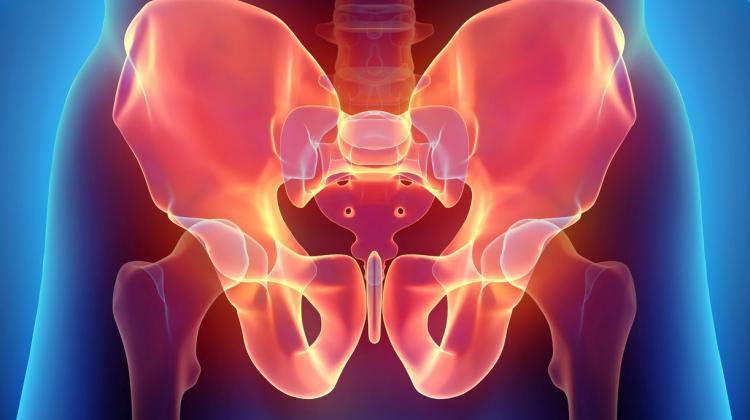Pelvises of contemporary modern men are different than pelvises from the Middle Ages
 Photo: Fotolia
Photo: Fotolia
The pelvises of contemporary men are larger, wider and more flattened than pelvises from the Middle Ages, according to scientists, including researchers from Poznań, who conducted comparative studies of over 50 pelvic brims. They explain that this anatomical change may be a consequence of a change in lifestyle.
Is the pelvic brim structure of medieval farmers different from the pelvises of contemporary men? Anna M. Kubicka from the Institute of Zoology of the University of Life Sciences in Poznań investigated this with Bartosz Musielak from the Department of Orthopedics and Pediatric Traumatology, Poznan University of Medical Sciences. Other scientists from the medical universities in Poznań and Łódź, Poznan University of Technology and the Independent Public Clinical Hospital in Otwock also took part in the research project.
According to Anna Kubicka, the pelvic brim is a fairly plastic part of the skeleton. "There are many publications whose authors analyse the influence of various factors on its shape. The main factors include the genetic background, age and sex of a given person, as well as the climate in which the person develops. Most papers concern women and the changing shape of the pelvis during puberty or menopause. There are few papers on different pelvic shapes in men" - she says.
Little is known about the effects of lifestyle on the pelvic bone morphology. "This especially concerns the changes associated with the transition from the agricultural lifestyle to the more modern lifestyle concentrated in cities. City residents have less mobility than their ancestors" - notes the anthropologist from the Institute of Zoology of the University of Life Sciences in Poznań.
As part of the study, the researchers compared pelvic brims of men belonging to two groups. One was the population of 22 men living in the period from the 10th to the 15th century in the area of Cedynia. The second group consisted of 31 contemporary men; CT scans of their pelvic brims were performed in a hospital in Poznań.
Researchers analysed the bones in two ways: by making classic measurements of lengths and angles, and by using geometric morphometry, which allowed to perform a detailed analysis of the shape changes and visualize the structural differences.
It turned out that the structures of pelvic brims of men from the Middle Ages were clearly different from those of contemporary men.
"In the Middle Ages, men`s pelvis were taller and narrower. In modern men, iliac wings are relatively more inclined downwards. In other words their pelvises are lower, wider and more obtuse, they possess quite a lot of women`s features" - says Anna Kubicka.
According to the authors, anatomical changes may reflect differences related to different physical activities in the Middle Ages and today. "The occupations of the men from Cedynia were mainly associated with agriculture, logging, construction - activities causing high mechanical loads. Today we have a sedentary lifestyle and move mainly by cars. These changes in physical activity are important for the skeleton" - the anthropologist says.
She notes that the pelvis is one of the most heavily loaded parts of the skeleton. It supports the weight of the upper body, transferring it to the lower limbs. In addition, during the development period it exhibits high plasticity, which in part allows to understand the changes in structure observed between the two groups.
The authors of the analyses also compared the body mass of men from both groups. In the medieval population, they estimated it on the basis of femoral head measurements, data on the modern population came from the hospital. They determined that the shape of pelvis in men was related to body weight. "The heavier the person is, the more the iliac wings are inclined downwards, and the larger the subpubic angle is. It is clear at first glance that the shape of the pelvis changes to better support the mass of the upper body" - says Anna Kubicka.
The anthropologist from Poznań notes that the structural differences between the pelvises of men from the Middle Ages and modern times are not enough to speak of evolution. "We are exploring a fairly short period, a thousand years, and only two populations. Evolutionary changes could be observed if we studied a larger sample of individuals in a decidedly longer time perspective. In the case of differences we have observed, we can only talk about adaptive changes related to decreased physical activity, lower mobility and larger weight" - she says.
Knowledge about the differences in the structure of pelvis can be important for forensic anthropology, and in the future perhaps also for understanding the background of various orthopaedic problems. Can the observed changes in pelvic shape in contemporary men affect later health problems of the musculoskeletal system? The research team leader Prof. Marek Jóźwiak and Dr. Bartosz Musielak from the Wiktor Dega Orthopaedic and Rehabilitation Clinical Hospital of the University of Medical Sciences in Poznań note that since the time of origin of the studied pelvises, the average life expectancy has doubled, and the overload changes are a multifactorial phenomenon that are also associated with age and activity.
"We are unable to say on the basis of the research whether the changes result in the deterioration of health. But the results improve the chances of success of therapeutic activities. Knowledge about the orientation of the acetabulum and pelvis allows to determine certain regularities that can be used in reconstructive orthopaedics" - the researchers say.
PAP - Science in Poland, Anna Ślązak
zan/ ekr/ kap/
tr. RL
Przed dodaniem komentarza prosimy o zapoznanie z Regulaminem forum serwisu Nauka w Polsce.















